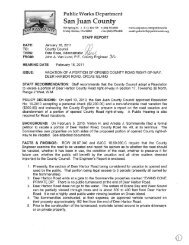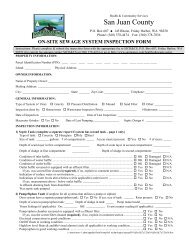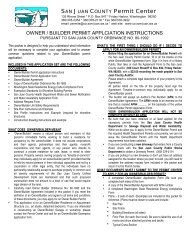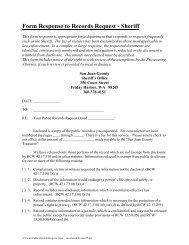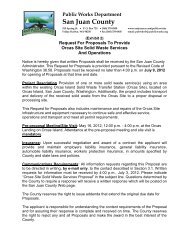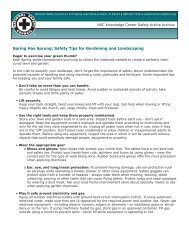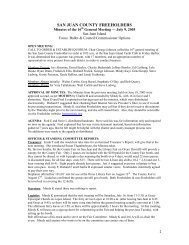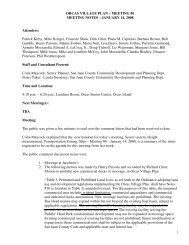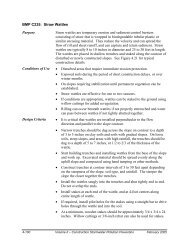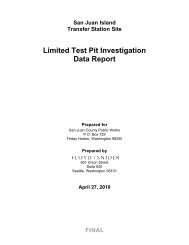Ordinance No._____- 2012 AN ORDINANCE ... - San Juan County
Ordinance No._____- 2012 AN ORDINANCE ... - San Juan County
Ordinance No._____- 2012 AN ORDINANCE ... - San Juan County
Create successful ePaper yourself
Turn your PDF publications into a flip-book with our unique Google optimized e-Paper software.
eing transported and deposited in more sensitive locations.<br />
Page 7 of 56<br />
Ord. ____-<strong>2012</strong><br />
While in most cases the proposed buffers should be adequate, a potential area of risk for lakes and<br />
ponds where the water has a longer residence time, is that 760% pollutant removal will not be<br />
adequate, and that harmful quantities of pollutants will be deposited or incorporated into the food<br />
chain, adversely impacting functions and values. This risk could be reduced by applying a larger buffer<br />
with a greater pollutant removal capability to lakes and ponds with little or no outflow.<br />
i. The tree protection zoneTree Protection Zone for Type Np and Type Ns streams flowing 6<br />
months or more per year are 50 feet and 30 feet respectively, which is consistent with the requirements<br />
under the Forest Practices Act. For streams flowing less than 6 months per year, a tree protection<br />
zoneTree Protection Zone is not required but stream bank vegetation must be retained, which is<br />
consistent with Wenger and Fowler (2000). In nearly all cases, these distances will be supplemented by<br />
the water quality component of the buffer which is described above.<br />
j. Under certain conditions, limited tree removal within tree protection zoneTree Protection Zones can<br />
occur without significantly affecting FWHCAs. Adequate numbers and configurations of trees must,<br />
however, be retained to preserve wind firm conditions (to prevent blow down), to provide shade, and<br />
to maintain normal hydrologic and habitat functions.<br />
Figure 3-3 of the BAS Synthesis provides information on distances necessary to reduce wind speed,<br />
with a tree protection zoneTree Protection Zone equivalent to one SPTH approximately 70-75%<br />
effective at reducing wind speed. Kleinschmidt (1999) also provides guidance on the management of<br />
buffers and tree protection zoneTree Protection Zones to prevent blow down, with a 35 foot no cut<br />
zone required next to the water (Zone 1), and at least another 35 feet (for a total of 70 feet) where<br />
some tree removal is allowed if minimum stocking levels are retained (referred to as Zone 2). Blow<br />
down rates can, however, vary depending on the spacing of trees within a tree stand (i.e., clusters),<br />
topography (tree stand orientation relative to the strongest winds), usual duration and depth of soil<br />
saturation, and other factors that are impractical to assess site-specifically in a <strong>County</strong> program.<br />
Chapter 4 of the BAS Synthesis cites a research study (Reid & Hilton 1998) that found tree protection<br />
zoneTree Protection Zones of 100 feet width were inadequate to protect adjoining trees from blow<br />
down, and that tree fall rates were abnormally high for a distance of at least 656 feet from edges. A<br />
wide range of buffer widths (55 to 800 feet) have been reported as being necessary to maintain the<br />
microclimate (soil temperature, moisture) within forested areas.<br />
In the outer zone (Zone 2) where the ordinance allows some tree removal, Kleinschmidt (1999) was<br />
used to establish minimum stocking levels necessary to protect wind firm conditions. For softwood<br />
stands such as Douglas fir, stocking levels are shown both in terms of basal area (which may be<br />
difficult for those without a forestry background to determine) and canopy cover. For softwood stands,<br />
80 s.f./acre of basal area (the amount that needs to be retained) was estimated to be approximately<br />
equivalent to 21% canopy cover based on the ratio of canopy cover to basal area for a fully stocked<br />
condition. From the State forest practice regulations, the basal area target at 140 years for all soil site<br />
classes is 325 s.f./acre, and the maximum attainable canopy cover for Douglas fir is approximately<br />
85%.<br />
A potential area of risk, where the regulations may depart from the science, is in allowing the<br />
construction of a primary structure within Zone 2 of the tree protection zone, which is proposed to<br />
allow property owners more flexibility in the siting of their homes. Kleinschmidt (1999) does not<br />
permit the construction of impervious surfaces within Zone 2 (which ranges from a width of 35 feet to<br />
195 feet). Their buffer sizing procedure, however, combines the water quality and tree protection<br />
components, while the procedure outlined in this ordinance separates them, with the construction of a<br />
primary structure only allowed outside the water quality-sensitivity component of the buffer. This may,<br />
N:\L<strong>AN</strong>D USE\LONG R<strong>AN</strong>GE PROJECTS\PCODES-11-0004 CAO FWHCAs\Docs from PC and CC\FWHCAOrdCC_<strong>2012</strong>-10-26.doc



